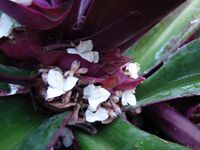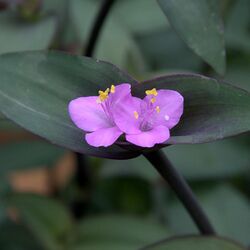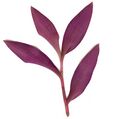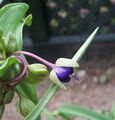Biology:Tradescantia
| Tradescantia | |
|---|---|
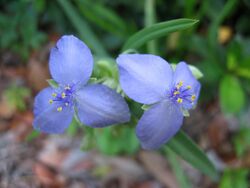
| |
| Tradescantia ohiensis | |
| Scientific classification | |
| Kingdom: | Plantae |
| Clade: | Tracheophytes |
| Clade: | Angiosperms |
| Clade: | Monocots |
| Clade: | Commelinids |
| Order: | Commelinales |
| Family: | Commelinaceae |
| Subfamily: | Commelinoideae |
| Tribe: | Tradescantieae |
| Subtribe: | Tradescantiinae |
| Genus: | Tradescantia Ruppius ex L.[1][2] |
| Type species | |
| Tradescantia virginiana | |
| Sections | |
|
Sections
| |
| Synonyms[2][3] | |
|
Synonyms
| |
File:Four Petals.tif Tradescantia (/ˌtrædəˈskæntiə/[4]) is a genus of 85 species[5] of herbaceous perennial wildflowers in the family Commelinaceae, native to the Americas from southern Canada to northern Argentina , including the West Indies. Members of the genus are known by many common names, including inchplant, wandering jew, spiderwort,[6] dayflower and trad.[7][8]
Tradescantia grow 30–60 cm tall (1–2 ft), and are commonly found individually or in clumps in wooded areas and open fields. They were introduced into Europe as ornamental plants in the 17th century and are now grown in many parts of the world. Some species have become naturalized in regions of Europe, Asia, Africa, and Australia , and on some oceanic islands.[3]
The genus's many species are of interest to cytogenetics because of evolutionary changes in the structure and number of their chromosomes.[9] They have also been used as bioindicators for the detection of environmental mutagens.[10] Some species have become pests to cultivated crops and considered invasive.
Description
Tradescantia are herbaceous perennials and include both climbing and trailing species, reaching 30–60 centimetres (0.98–1.97 ft) in height. The leaves are long, thin and blade-like to lanceolate, from 3–45 cm long (1.2–17.7 in). The flowers can be white, pink, purple or blue, with three petals and six yellow anthers (or rarely, four petals and eight anthers). The sap is mucilaginous and clear.
A number of species have flowers that last for only a day, opening in the morning and closing by the evening.[11]
Etymology
The scientific name of the genus chosen by Carl Linnaeus honours the English naturalists and explorers John Tradescant the Elder (c. 1570s – 1638) and John Tradescant the Younger (1608–1662),[12][13] who introduced many new plants to English gardens. Tradescant the Younger mounted three expeditions to the new colony of Virginia.[14] From there, the type species, Tradescantia virginiana, was brought to England in 1629.
Plants of the genus are called by many common names, varying by region and country. The name "inchplant" is thought to describe the plant's fast growth,[15] or the fact that leaves are an inch apart on the stem.[16] "Spiderwort" refers to the sap which dries into web-like threads when a stem is cut. [17] The name "dayflower", shared with other members of the Commelinaceae family, refers to the flowers which open and close within a single day.
The controversial name "wandering Jew" originates from the Christian myth of the Wandering Jew, condemned to wander the earth for taunting Jesus on the way to his crucifixion.[18] In recent years there have been efforts to stop using this and other potentially offensive common names,[19] in favour of alternatives such as "wandering dude".[20][21]
In Spanish, Tradescantia plants are sometimes referred to as flor de Santa Lucía (Saint Lucy's flower), in reference to the Saint's reputation as the patron saint of sight, and the use of the juice of the plant as eye drops to relieve congestion.[22]
Taxonomy
Subdivisions and species
The number of species and infrageneric taxa has changed throughout history. The first major classification proposed by Hunt (1980) included 60 species divided into eight sections, with one section divided into a further four series.[23] Hunt's 1986 revision united several small genera with Tradescantia as sections, resulting in a total of twelve sections comprising 68 species,[24] and this infrageneric classification was accepted for several decades.
A recent study by Pellegrini (2017) proposed a new classification based on recent morphological research, dividing the genus into five subgenera.[25] As of December 2023, The Royal Botanic Gardens, Kew recognises 86 species.[5]
|
|
Unclassified
- Tradescantia petiolaris M.E.Jones
Formerly placed here
- Tradescantia × andersoniana W.Ludw. & Rohweder[35][36] The name was published with no description, so is not a valid botanical name;[37] the taxon is now treated as a cultivar group.[38]
- Callisia navicularis (Ortgies) D.R.Hunt (as T. navicularis Ortgies)
- Callisia warszewicziana (Kunth & C.D.Bouché) D.R.Hunt (as T. warszewicziana Kunth & C.D.Bouché)
- Gibasis geniculata (Jacq.) Rohweder (as T. geniculata Jacq.)
- Gibasis karwinskyana (Schult. & Schult.f.) Rohweder (as T. karwinskyana Schult. & Schult.f.)
- Gibasis pellucida (M.Martens & Galeotti) D.R.Hunt (as T. pellucida M.Martens & Galeotti)
- Siderasis fuscata (Lodd. et al.) H.E.Moore (as T. fuscata Lodd. et al.)
- Tinantia anomala (Torr.) C.B.Clarke (as T. anomala Torr.)
- Tripogandra diuretica (Mart.) Handlos (as T. diuretica Mart.)
- Elasis hirsuta (Kunth) D.R.Hunt (as T. hirsuta)[25]
Distribution and habitat
The first species described, the Virginia spiderwort, T. virginiana, is native to the eastern United States from Maine to Alabama, and Canada in southern Ontario. Virginia spiderwort was introduced to Europe in 1629, where it is cultivated as a garden flower.
The natural range of the genus as a whole spans nearly the entire length and width of mainland North America, from Canada through Mexico and Central America, and thrives in a great diversity of temperate and tropical habitats. It is frequently found in thinly wooded deciduous forests, plains, prairies, and healthy fields, often alongside other native wildflowers.
Conservation
The western spiderwort T. occidentalis is listed as an endangered species in Canada, where the northernmost populations of the species are found at a few sites in southern Saskatchewan, Manitoba and Alberta; it is more common further south in the United States to Texas and Arizona.
Cultivation
Spiderworts are popular in Europe and North America as ornamental plants. Temperate species are grown as hardy garden perennials, while tropical species such as T. zebrina and T. spathacea are used as house plants.[13] Their popularity and easy spreading nature has led to some species being considered serious weeds in certain places (see below).
Most cold-hardy garden plants belong to the Andersoniana Group (often referred to with the invalid name Tradescantia × andersoniana).[39] This is a group of interspecific hybrids developed from Tradescantia virginiana, T. ohiensis, and T. subaspera, which have overlapping ranges within continental North America.[13] These plants are clump-forming herbaceous perennials, with individual cultivars mainly differing in flower colour.[40]
A wide range of tender tropical species are cultivated as houseplants or outdoor annuals in temperate locations, including Tradescantia zebrina, T. fluminensis, T. spathacea, T. sillamontana, and T. pallida.[41][42] They are typically grown for their foliage, and many have colourful variegated patterns of silver, purple, green, pink, and gold.[42]
Cultivars
The following cultivars have gained the Royal Horticultural Society's Award of Garden Merit:[43]
- T. (Andersoniana Group) 'Concord Grape'
- T. cerinthoides 'Nanouk'
- T. cerinthoides 'Variegata'
- T. fluminensis 'Aurea'
- T. fluminensis 'Quicksilver'
- T. pallida 'Purpurea'
- T. spathacea 'Rainbow'
- T. zebrina 'Purpusii'
- T. zebrina 'Quadricolor'
The International Society for Horticultural Science appointed Tradescantia Hub as an International Cultivar Registration Authority (ICRA) for Tradescantia in 2022. As an ICR authority, the Hub is responsible for recording and maintaining a checklist of the correct names for all cultivars in the genus.[44]
Weeds
Due to its ready propagation from stem fragments and its domination of the ground layer in many forest environments, T. fluminensis has become a major environmental weed in Australia,[45] New Zealand and the southern United States.[46] Other species considered invasive weeds in certain places include T. pallida,[47] T. spathacea,[48] and T. zebrina.[49]
Toxicity
Some members of the genus Tradescantia may cause allergic reactions in pets (especially cats and dogs) characterised by red, itchy skin.[50] Notable culprits include T. albiflora (scurvy weed), T. spathacea (Moses in the cradle), and T. pallida (purple heart).
Uses
Native Americans used T. virginiana to treat a number of conditions, including stomachache. It was also used as a food source.[13] The cells of the stamen hairs of some Tradescantia are colored blue, but when exposed to sources of ionizing radiation such as gamma rays or pollutants like sulphur dioxide from industries, the cells mutate and change color to pink; they are one of the few tissues known to serve as an effective bioassay for ambient radiation levels.[10][13]
Gallery
Front view of leaves of Tradescantia pallida 'Purpurea'
Back view of leaves of Tradescantia pallida 'Purpurea'
Front view of leaves of Tradescantia zebrina 'Tricolor'
Back view of leaves of Tradescantia zebrina 'Tricolor'
References
- ↑ Linnaeus Sp. Pl.: 288 (1753).
- ↑ 2.0 2.1 "Genus: Tradescantia L.". Germplasm Resources Information Network. United States Department of Agriculture. 2004-08-10. http://www.ars-grin.gov/cgi-bin/npgs/html/genus.pl?12239.
- ↑ 3.0 3.1 "Kew World Checklist of Selected Plant Families". Royal Botanic Gardens, Kew. http://apps.kew.org/wcsp/namedetail.do?name_id=270160.
- ↑ Brenzel, Kathleen Norris, ed (March 1995) (in en). Sunset western garden book. Sunset Books (6th ed.). Menlo Park, California: Sunset Publishing Corporation. pp. 606–607. ISBN 0-376-03851-9. OCLC 32666922. https://www.worldcat.org/oclc/32666922.
- ↑ 5.0 5.1 "Tradescantia Ruppius ex L.". Royal Botanic Gardens, Kew. https://powo.science.kew.org/taxon/urn:lsid:ipni.org:names:60436455-2.
- ↑ "Tradescantia". Natural Resources Conservation Service PLANTS Database. USDA. https://plants.usda.gov/core/profile?symbol=TRADE.
- ↑ "Tradescantia (Spiderwort) Planting and Growing Guide". https://www.seasonalgardening.co.uk/perennials/tradescantia.asp.
- ↑ "Wandering Jew or Trad". https://www.daf.qld.gov.au/__data/assets/pdf_file/0009/56916/wandering-trad.pdf.
- ↑ Golczyk, H. (2011). "Structural Heterozygosity, Duplication of Telomeric (TTTAGGG)n Clusters and B Chromosome Architecture in Tradescantia virginiana L." (in en). Cytogenetic and Genome Research 134 (3): 234–242. doi:10.1159/000328915. ISSN 1424-8581. PMID 21709415. https://www.karger.com/Article/FullText/328915.
- ↑ 10.0 10.1 Ichikawa, Sadao (1972). "Somatic Mutation Rate in Tradescantia Stamen Hairs at Low Radiation Levels: Finding of Low Doubling Doses of Mutations". The Japanese Journal of Genetics 47 (6): 411–421. doi:10.1266/jjg.47.411.
- ↑ Tilley, Nikki. "Growing Spiderworts". https://www.gardeningknowhow.com/ornamental/flowers/spiderwort/growing-spiderworts.htm.
- ↑ Quattrocchi, Umberto (2000). CRC World Dictionary of Plant Names: Common Names, Scientific Names, Eponyms, Synonyms, and Etymology. IV R-Z. Taylor & Francis US. p. 2697. ISBN 978-0-8493-2678-3. https://books.google.com/books?id=zIOvJSJs-IkC.
- ↑ 13.0 13.1 13.2 13.3 13.4 Hawke 2010.
- ↑ Lorenzo-Cáceres, José Manuel Sánchez de (2004). "Las especies del género Tradescantia cultivadas en España" (in es). http://www.arbolesornamentales.es/Tradescantia.htm.
- ↑ "Inch Plants". https://www.almanac.com/plant/wandering-jew.
- ↑ "Tradescantia zebrina". https://plants.ces.ncsu.edu/plants/tradescantia-zebrina/.
- ↑ Holland, Jonah (2014-06-06). "Spiderwort: Why's It Called That Anyway?". Lewis Ginter Botanical Garden. https://www.lewisginter.org/spiderwort-whys-it-called-that-anyway/.
- ↑ Anderson, George K. The Legend of the Wandering Jew. Providence: Brown University Press, 1965. xi, 489 p.; ISBN:0-87451-547-5
- ↑ Jackson, MJ (2020-08-09). "Racism in Taxonomy: What's in a Name?" (in en-US). Hoyt Arboretum. https://www.hoytarboretum.org/racism-in-taxonomy-whats-in-a-name/.
- ↑ "Why We're No Longer Using the Name Wandering Jew". 2019-06-26. https://bloomboxclub.com/blogs/news/why-were-no-longer-using-the-name-wandering-jew.
- ↑ Goldwyn, Brittany (2019-07-23). "How to Care for a Wandering Tradescantia Zebrina Plant" (in en-US). https://www.bybrittanygoldwyn.com/how-to-care-for-a-wandering-jew-plant/.
- ↑ Bugatti Para, Cristina L. de (2008-05-17). "Esos yuyos con aire lujoso" (in es). La Nación. https://www.lanacion.com.ar/propiedades/esos-yuyos-con-aire-lujoso-nid1012713/.
- ↑ Hunt, David R. (1980). "Sections and Series in Tradescantia: American Commelinaceae: IX". Kew Bulletin 35 (2): 437–442. doi:10.2307/4114596.
- ↑ Hunt, David R. (1986). "Campelia, Rhoeo and Zebrina united with Tradescantia: American Commelinaceae: XIII". Kew Bulletin 41 (2): 401–405. doi:10.2307/4102948.
- ↑ 25.0 25.1 Pellegrini, Marco (26 Oct 2017). "Morphological phylogeny of Tradescantia L. (Commelinaceae) sheds light on a new infrageneric classification for the genus and novelties on the systematics of subtribe Tradescantiinae". PhytoKeys (89): 11–72. doi:10.3897/phytokeys.89.20388. PMID 29118649. PMC 5672149. https://phytokeys.pensoft.net/article/20388/list/8/. Retrieved 4 February 2022.
- ↑ Pellegrini, Marco (19 July 2018). "Wandering throughout South America: Taxonomic revision of Tradescantia subg. Austrotradescantia (D.R.Hunt) M.Pell. (Commelinaceae)". PhytoKeys (104): 1–97. doi:10.3897/phytokeys.104.28484. PMC 6062585. https://phytokeys.pensoft.net/article/28484/list/8/. Retrieved 4 February 2022.
- ↑ Hassemer, Gustavo; Funez, Luís (1 September 2020). "Novelties and notes on Tradescantia (Commelinaceae) from Brazil". Phytotaxa 458 (2): 139-158. doi:10.11646/phytotaxa.458.2.2. https://phytotaxa.mapress.com/pt/article/view/phytotaxa.458.2.2. Retrieved 6 December 2023.
- ↑ Pellegrini, M.O.O. (2020). "Tradescantia cerinthoides Kunth". Jardim Botânico do Rio de Janeiro. http://reflora.jbrj.gov.br/reflora/floradobrasil/FB126854.
- ↑ Pellegrini, M.O.O. (2020). "Tradescantia chrysophylla M.Pell.". Jardim Botânico do Rio de Janeiro. http://reflora.jbrj.gov.br/reflora/floradobrasil/FB582998.
- ↑ Pellegrini, M.O.O. (2020). "Tradescantia crassula Link & Otto". Jardim Botânico do Rio de Janeiro. http://reflora.jbrj.gov.br/reflora/floradobrasil/FB126855.
- ↑ Pellegrini, M.O.O. (2020). "Tradescantia decora W.Bull". Jardim Botânico do Rio de Janeiro. http://reflora.jbrj.gov.br/reflora/floradobrasil/FB127654.
- ↑ Pellegrini, M.O.O. (2020). "Tradescantia mundula Kunth". Jardim Botânico do Rio de Janeiro. http://reflora.jbrj.gov.br/reflora/floradobrasil/FB127679.
- ↑ Hunt, D. R. (1986). "Campelia, Rhoeo and Zebrina united with Tradescantia: American Commelinaceae: XIII". Kew Bulletin 41 (2): 401–405. doi:10.2307/4102948. ISSN 0075-5974. https://www.jstor.org/stable/4102948.
- ↑ Hunt, D. R. (1980). "Sections and series in Tradescantia: American Commelinaceae: IX". Kew Bulletin 35 (2): 437–442. doi:10.2307/4114596. ISSN 0075-5974. https://www.jstor.org/stable/4114596.
- ↑ Ludwig, Wolfgang; Rohweder, Otto (1954). "Zur Nomenklatur zweier Commelinaceen". Feddes Repertorium Specierum Novarum Regni Vegetabilis 56 (3): 282. doi:10.1002/fedr.19540560304.
- ↑ "Tradescantia × andersoniana". Royal Botanic Gardens, Kew. https://powo.science.kew.org/taxon/urn:lsid:ipni.org:names:173208-1.
- ↑ Walters, S.M.; Brady, A.; Brickell, C.D.; Cullen, J.; Green, P.S.; Lewis, J.; Matthews, V.A.; Webb, D.A. et al. (1989). European Garden Flora: Volume II. Cambridge University Press. p. 31.
- ↑ "Tradescantia Andersoniana Group". https://www.rhs.org.uk/plants/142510/tradescantia-andersoniana-group/details.
- ↑ Dave's Garden 2015, Tod Boland. Spiderwort Hybrids - Tradescantia X andersoniana. September 1, 2012.
- ↑ Christman 2005.
- ↑ Espiritu, Kevin (23 March 2017). "Wandering Jew Plant: Care, Types, and Growing Tips". Epic Gardening. https://www.epicgardening.com/wandering-jew-plant.
- ↑ 42.0 42.1 "Tradescantia". Better Homes & Gardens. https://www.bhg.com/gardening/plant-dictionary/houseplant/tradescantia.
- ↑ "AGM Plants April 2023 (C) RHS - Ornamental". Royal Horticultural Society. https://www.rhs.org.uk/plants/pdfs/agm-lists/agm-ornamentals.pdf.
- ↑ "ICRA Report Sheet: Tradescantia Hub". International Society for Horticultural Science. https://www.ishs.org/sci/icralist/109.htm.
- ↑ "Tradescantia fluminensis" (in en). Atlas of Living Australia. August 2007. https://profiles.ala.org.au/opus/weeds-australia/profile/Tradescantia%20fluminensis.
- ↑ Witt, A; Luke, Q, eds (2017). Tradescantia fluminensis (wandering Jew). Cabi.org. doi:10.1079/9781786392145.0000. ISBN 9781786392145. https://www.cabi.org/ISC/datasheet/54389. Retrieved 2020-07-08.
- ↑ Witt, A; Luke, Q, eds (2017). Tradescantia pallida (purple queen). Cabi.org. doi:10.1079/9781786392145.0000. ISBN 9781786392145. https://www.cabi.org/ISC/datasheet/117574. Retrieved 2020-07-08.
- ↑ Witt, A; Luke, Q, eds (2017). Tradescantia spathacea (boat lily). Cabi.org. doi:10.1079/9781786392145.0000. ISBN 9781786392145. https://www.cabi.org/ISC/datasheet/119453. Retrieved 2020-07-08.
- ↑ Witt, A; Luke, Q, eds (2017). Tradescantia zebrina (wandering jew). Cabi.org. doi:10.1079/9781786392145.0000. ISBN 9781786392145. https://www.cabi.org/ISC/datasheet/110354. Retrieved 2020-07-08.
- ↑ "Inch Plant" (in en). American Society for the Prevention of Cruelty to Animals. https://www.aspca.org/pet-care/animal-poison-control/toxic-and-non-toxic-plants/inch-plant.
Bibliography
- Christman, Steve (10 March 2005). "Tradescantia Andersoniana Group". http://mobile.floridata.com/Plants/Commelinaceae/Tradescantia%20Andersoniana%20Group/658.
- Dave's Garden (2015). "Welcome to Dave's Garden!". Internet Brands. http://davesgarden.com/.
- Hawke, Richard G. (2010). "A Comparative Study of Tradescantia Cultivars". Plant Evaluation Notes (34): 1–9. https://www.chicagobotanic.org/downloads/planteval_notes/no34_tradescantia.pdf. Retrieved 14 June 2015.
- Beal, Janet. "Common Names for Tradescantia Flowers". http://homeguides.sfgate.com/common-names-tradescantia-flowers-63350.html.
- Edgar, Anderson; Karl, Sax (March 1936). "A Cytological Monograph of the American Species of Tradescantia". Botanical Gazette 97 (3): 433–476. doi:10.1086/334582.
External links
| Wikisource has the text of the 1920 Encyclopedia Americana article Spiderwort. |
- Flora of North America: Tradescantia (includes species in USA and Canada only)
- PlantSystematics: Tradescantia[no|permanent dead link|dead link}}]
- Western Spiderwort endangered in Canada
Wikidata ☰ Q157498 entry
 |

